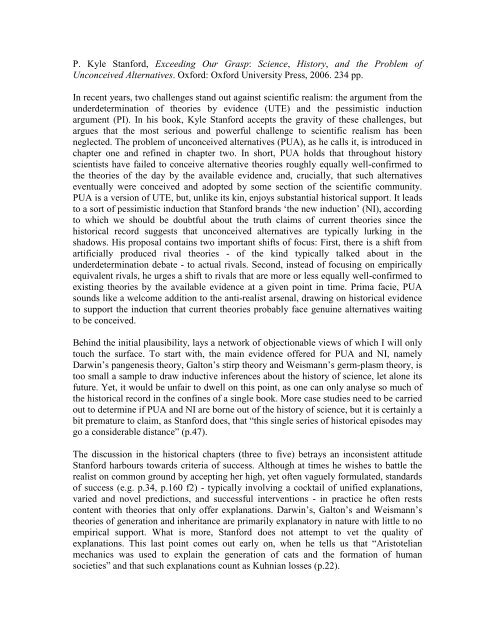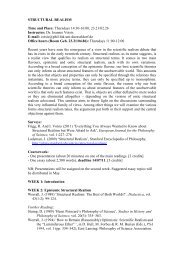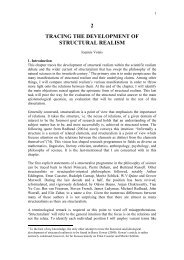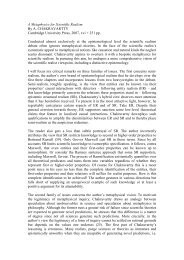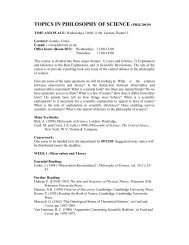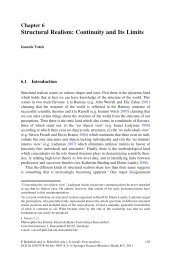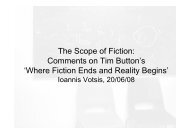Review of Kyle Stanford's Exceeding Our Grasp - Ioannis Votsis
Review of Kyle Stanford's Exceeding Our Grasp - Ioannis Votsis
Review of Kyle Stanford's Exceeding Our Grasp - Ioannis Votsis
You also want an ePaper? Increase the reach of your titles
YUMPU automatically turns print PDFs into web optimized ePapers that Google loves.
P. <strong>Kyle</strong> Stanford, <strong>Exceeding</strong> <strong>Our</strong> <strong>Grasp</strong>: Science, History, and the Problem <strong>of</strong><br />
Unconceived Alternatives. Oxford: Oxford University Press, 2006. 234 pp.<br />
In recent years, two challenges stand out against scientific realism: the argument from the<br />
underdetermination <strong>of</strong> theories by evidence (UTE) and the pessimistic induction<br />
argument (PI). In his book, <strong>Kyle</strong> Stanford accepts the gravity <strong>of</strong> these challenges, but<br />
argues that the most serious and powerful challenge to scientific realism has been<br />
neglected. The problem <strong>of</strong> unconceived alternatives (PUA), as he calls it, is introduced in<br />
chapter one and refined in chapter two. In short, PUA holds that throughout history<br />
scientists have failed to conceive alternative theories roughly equally well-confirmed to<br />
the theories <strong>of</strong> the day by the available evidence and, crucially, that such alternatives<br />
eventually were conceived and adopted by some section <strong>of</strong> the scientific community.<br />
PUA is a version <strong>of</strong> UTE, but, unlike its kin, enjoys substantial historical support. It leads<br />
to a sort <strong>of</strong> pessimistic induction that Stanford brands ‘the new induction’ (NI), according<br />
to which we should be doubtful about the truth claims <strong>of</strong> current theories since the<br />
historical record suggests that unconceived alternatives are typically lurking in the<br />
shadows. His proposal contains two important shifts <strong>of</strong> focus: First, there is a shift from<br />
artificially produced rival theories - <strong>of</strong> the kind typically talked about in the<br />
underdetermination debate - to actual rivals. Second, instead <strong>of</strong> focusing on empirically<br />
equivalent rivals, he urges a shift to rivals that are more or less equally well-confirmed to<br />
existing theories by the available evidence at a given point in time. Prima facie, PUA<br />
sounds like a welcome addition to the anti-realist arsenal, drawing on historical evidence<br />
to support the induction that current theories probably face genuine alternatives waiting<br />
to be conceived.<br />
Behind the initial plausibility, lays a network <strong>of</strong> objectionable views <strong>of</strong> which I will only<br />
touch the surface. To start with, the main evidence <strong>of</strong>fered for PUA and NI, namely<br />
Darwin’s pangenesis theory, Galton’s stirp theory and Weismann’s germ-plasm theory, is<br />
too small a sample to draw inductive inferences about the history <strong>of</strong> science, let alone its<br />
future. Yet, it would be unfair to dwell on this point, as one can only analyse so much <strong>of</strong><br />
the historical record in the confines <strong>of</strong> a single book. More case studies need to be carried<br />
out to determine if PUA and NI are borne out <strong>of</strong> the history <strong>of</strong> science, but it is certainly a<br />
bit premature to claim, as Stanford does, that “this single series <strong>of</strong> historical episodes may<br />
go a considerable distance” (p.47).<br />
The discussion in the historical chapters (three to five) betrays an inconsistent attitude<br />
Stanford harbours towards criteria <strong>of</strong> success. Although at times he wishes to battle the<br />
realist on common ground by accepting her high, yet <strong>of</strong>ten vaguely formulated, standards<br />
<strong>of</strong> success (e.g. p.34, p.160 f2) - typically involving a cocktail <strong>of</strong> unified explanations,<br />
varied and novel predictions, and successful interventions - in practice he <strong>of</strong>ten rests<br />
content with theories that only <strong>of</strong>fer explanations. Darwin’s, Galton’s and Weismann’s<br />
theories <strong>of</strong> generation and inheritance are primarily explanatory in nature with little to no<br />
empirical support. What is more, Stanford does not attempt to vet the quality <strong>of</strong><br />
explanations. This last point comes out early on, when he tells us that “Aristotelian<br />
mechanics was used to explain the generation <strong>of</strong> cats and the formation <strong>of</strong> human<br />
societies” and that such explanations count as Kuhnian losses (p.22).
The only potentially impressive predictive accomplishments in Stanford’s discussion <strong>of</strong><br />
the three theories <strong>of</strong> generation and inheritance boil down to Weismann’s prediction <strong>of</strong><br />
reduction division, something he brands “a previously unknown phenomenon in the<br />
history <strong>of</strong> biology” (p.130). The prediction, i.e. germ cells receive half <strong>of</strong> the germinal<br />
material <strong>of</strong> the parent cell, fails to impress when compared to the staple <strong>of</strong> novel<br />
predictions one finds in physics, where theoretically calculated values approach the<br />
observed values to many decimal places. Moreover, the phenomenon was neither<br />
previously unknown, nor clearly unexpected. As Stanford notes earlier in that chapter,<br />
Edouard van Beneden had already identified “‘maturation division’ (later termed<br />
‘reduction division’ by Weismann)” (p.106). He also notes that Weismann “became<br />
aware <strong>of</strong> van Beneden’s work and realised that… reduction division… fit his own<br />
theoretical predictions” (pp.106-7). Stanford <strong>of</strong>fers no independent confirmation that this<br />
was indeed the order <strong>of</strong> events, simply taking Weismann’s word for it. But let us not be<br />
unduly uncharitable. Perhaps, the phenomenon was unexpected but a welcome<br />
consequence <strong>of</strong> Weismann’s theory. Since Stanford uses this example to argue against<br />
the realists’ reliance on novel predictions (p.130, p.181, p.207), one anticipates an<br />
elaboration <strong>of</strong> the story behind Weismann’s prediction that answers the typical realist<br />
concerns on such matters, e.g. whether reduction division was a consequence <strong>of</strong> only<br />
some features <strong>of</strong> Weismann’s theory, whether these features survived into our modern<br />
account, etc. Instead, all we are told is that Weismann made this prediction “on the basis<br />
<strong>of</strong> purely theoretical considerations” (p. 136, f7).<br />
The three historical case studies prop up PUA, but only because its demands on genuine<br />
rivals are so meagre. PUA’s sole requirement is that rivals are roughly equally wellconfirmed<br />
by the available evidence. In a footnote, Stanford lowers the demands even<br />
further saying that strictly speaking alternatives should not be “effectively ruled out by<br />
the [available] evidence” (p.26, f10) [original emphasis]. He goes on to say that the<br />
stronger requirement, namely “roughly equally well-confirmed by the available<br />
evidence”, though not necessary is defensible and “deflects any suggestion that such<br />
alternatives were ignored on evidential grounds” (ibid.). Both requirements are simply<br />
too weak. Theories or theory parts can count as genuine rivals even if there is no evidence<br />
available whatsoever. Indeed, that’s precisely what Stanford has in mind with the<br />
aforementioned theories, for he prides himself that (at least with respect to the<br />
unconceived parts) “there simply was no available evidence” (p.134). Equally shocking is<br />
his use <strong>of</strong> this lack <strong>of</strong> evidence to thwart any objections about how easy it is “to judge<br />
that a given alternative was even roughly as well confirmed” (ibid.). But to suggest that<br />
lack <strong>of</strong> evidence can convey (a) what counts as a genuine rival and (b) what counts as<br />
more or less roughly well confirmed is to reduce PUA to a lame duck. Or, to borrow one<br />
<strong>of</strong> Stanford’s expressions, PUA becomes ‘a pyrrhic victory’ for the anti-realist.<br />
Chapters six and seven are by far the most philosophically rewarding. There Stanford<br />
undertakes to defeat various realist replies to PI, for he takes some <strong>of</strong> them to also<br />
threaten PUA (p.141). Quite a few <strong>of</strong> the objections he raises are not original, e.g. the<br />
deficiencies <strong>of</strong> pure descriptivist and <strong>of</strong> pure causal theories <strong>of</strong> reference, but they are<br />
rendered in an incisive manner. The most sophisticated recent defence <strong>of</strong> realism,
selective confirmation, consumes the whole <strong>of</strong> chapter seven. Against it, Stanford raises<br />
his centerpiece objection, i.e. realist criteria <strong>of</strong> success aiming to distinguish between<br />
essential and idle parts <strong>of</strong> theories “are either not prospectively applicable at all, fail to<br />
distinguish the parts <strong>of</strong> present theories realists hoped to defend from any others, or<br />
require us to exercise discriminatory abilities whose reliability is itself subject to an<br />
historical challenge” (pp.183-4).<br />
Stanford’s dismissal <strong>of</strong> some realist strategies towards selective confirmation is at times<br />
hasty and injudicious. His dismissal <strong>of</strong> the structural realist strategy, for example, reveals<br />
a lack <strong>of</strong> familiarity with the relevant literature. Contra Stanford’s charge that it is unclear<br />
whether we can plausibly distinguish structure from non-structure, it can be pointed out<br />
that ‘structure’ denotes specifications <strong>of</strong> nature up to isomorphism while ‘non-structure’<br />
denotes specifications that go beyond isomorphism (p.181). Furthermore, his charge that<br />
the structural realist “leaves us with no justifiable confidence in our ability to clearly<br />
distinguish” essential from idle features <strong>of</strong> theories (p.183) seems to be based on the<br />
erroneous assumption that the structural realist is committed to all and only fundamental<br />
theoretical structures. Yet, the structural realist is neither committed to Weismann’s<br />
admittedly structural claim about germinal specificity (p.181) because it possessed no<br />
independent confirmation nor stunned by the non-fundamental status <strong>of</strong> Galton’s<br />
ancestral law <strong>of</strong> inheritance in contemporary genetics (p.182) because there is no<br />
restriction to believe only fundamental theoretical structures. As for Stanford’s allegation<br />
that structural realism is consequently forced to retreat to such vague and general<br />
statements as “[structure] will be recoverable in some way, somewhere, somehow from<br />
future science” (ibid.) [original emphasis], the following robust proposal can be given as<br />
a response: Not all structures survive theory change, but all genuinely successful theory<br />
features survive, either intact or suitably modified (via non-trivial correspondence rules),<br />
and are structural.<br />
This book fails to convince the reader <strong>of</strong> its main proposals, from PUA and NI to what<br />
seems to be a new brand <strong>of</strong> instrumentalism put forth in the eighth and final chapter. The<br />
book nonetheless succeeds in stimulating a rethink <strong>of</strong> the underdetermination problem. It<br />
does so by calling into question what ingredients are necessary for a strong<br />
underdetermination recipe, suggesting that something less than empirical equivalence and<br />
something more than artificially produced rivals will do just as well, if not better.<br />
Dr. <strong>Ioannis</strong> <strong>Votsis</strong><br />
Philosophisches Institut<br />
Heinrich Heine Universität Düsseldorf<br />
Universitätsstraße 1<br />
Gebäude 23.21/04.86<br />
D-40225 Düsseldorf<br />
Germany<br />
Email: votsis@phil-fak.uni-duesseldorf.de


